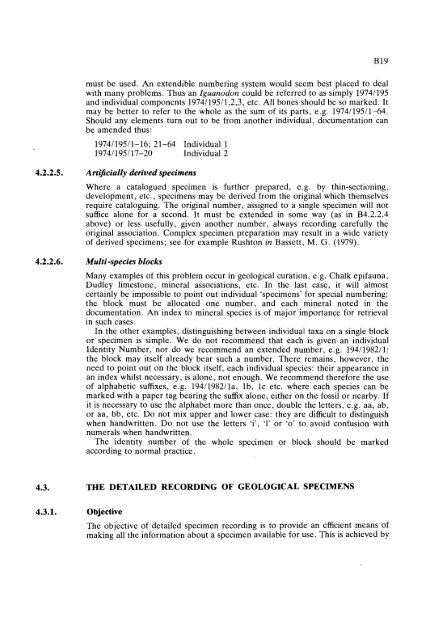GUIDELINES FOR THE CURATION OF GEOLOGICAL MATERIALS
GUIDELINES FOR THE CURATION OF GEOLOGICAL MATERIALS
GUIDELINES FOR THE CURATION OF GEOLOGICAL MATERIALS
Create successful ePaper yourself
Turn your PDF publications into a flip-book with our unique Google optimized e-Paper software.
must be used. An extendible numbering system would seem best placed to deal<br />
with many problems. Thus an Iguanodon could be referred to as simply 19741195<br />
and individual components 1974/195/1,2,3, etc. All bones should be so marked. It<br />
may be better to refer to the whole as the sum of its parts, e.g. 1974119511-64.<br />
Should any elements turn out to be from another individual, documentation can<br />
be amended thus:<br />
1974119511-16; 21-64 Individual 1<br />
19741195117-20 Individual 2<br />
4.2.2.5. Artificially derived specimens<br />
Where a catalogued specimen is further prepared, e.g. by thin-sectioning,<br />
development, etc., specimens may be derived from the original which themselves<br />
require cataloguing. The original number, assigned to a single specimen will not<br />
suffice alone for a second. It must be extended in some way (as in B4.2.2.4<br />
above) or less usefully, given another number, always recording carefully the<br />
original association. Complex specimen preparation may result in a wide variety<br />
of derived specimens; see for example Rushton in Bassett, M. G. (1979).<br />
4.2.2.6. Multi -species blocks<br />
Many examples of this problem occur in geological curation, e.g. Chalk epifauna,<br />
Dudley limestone, mineral associations, etc. In the last case, it will almost<br />
certainly be impossible to point out individual 'specimens' for special numbering:<br />
the block must be allocated one number, and each mineral noted in the<br />
documentation. An index to mineral species is of major importance for retrieval<br />
in such cases.<br />
In the other examples, distinguishing between individual taxa on a single block<br />
or specimen is simple. We do not recommend that each is given an individual<br />
Identity Number, nor do we recommend an extended number, e.g. 1941198211:<br />
the block may itself already bear such a number. There remains, however, the<br />
need to point out on the block itself, each individual species: their appearance in<br />
an index whilst necessary, is alone, not enough. We recommend therefore the use<br />
of alphabetic suffixes, e.g. 194/198211a, lb, lc etc. where each species can be<br />
marked with a paper tag bearing the suffix alone, either on the fossil or nearby. If<br />
it is necessary to use the alphabet more than once, double the letters, e.g. aa, ab,<br />
or aa, bb, etc. Do not mix upper and lower case: they are difficult to distinguish<br />
when handwritten. Do not use the letters 'i', 'l' or '0' to avoid confusion with<br />
numerals when handwritten.<br />
The identity number of the whole specimen or block should be marked<br />
according to normal practice.<br />
<strong>THE</strong> DETAILED RECORDING <strong>OF</strong> <strong>GEOLOGICAL</strong> SPECIMENS<br />
Objective<br />
The objective of detailed specimen recording is to provide an efficient means of<br />
making all the information about a specimen available for use. This is achieved by

















